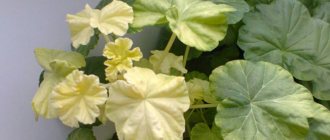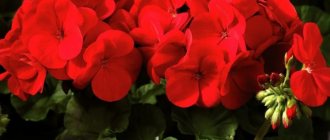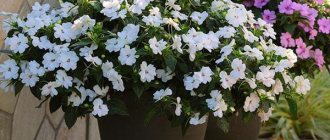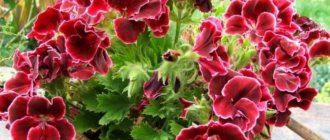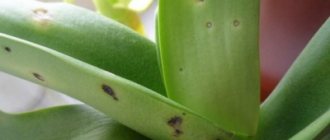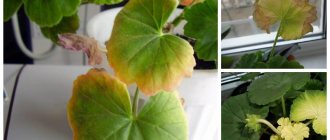Features of indoor flower growth
Before purchasing any plant, first of all, you need to study a large amount of information: what soil it prefers, where it is better to plant, what fertilizers it likes, how to water it. All these questions should be answered in advance so that later you do not have to solve problems due to a mistake in care.
There is no specific answer to the question of why the leaves of a flower turn red. Just when growing a flower you should take into account the specific care.
In decorative floriculture there are several varieties of the geranium family:
- photophilous;
- shade-loving;
- shade-tolerant;
- drought-resistant.
Therefore, despite the unpretentiousness of the plant, it is important to understand that each type of geranium requires the right approach. If light-loving pelargonium is planted on a north window, it will eventually get sick or die.
The most striking indicator of successful growth is appearance. Withered inflorescences should be removed, young shoots should be pinched to speed up growth and flowering. Annual pruning will help maintain the aesthetic appearance of geraniums.
Prevention and care at home
Basically, all ailments of a houseplant arise due to irregularities in care (read about the features of caring for pelargonium at home here). Pelargonium needs fresh air. Ventilate the room regularly. This is the prevention of fungal diseases. Maintain a comfortable temperature regime, control lighting and soil and air humidity. Feed the soil periodically and inspect the plant for parasites.
Geraniums get sick if they are not properly cared for or as a result of infection by a fungus, bacteria or virus. Water your indoor beauty, avoiding overwatering and drying out, do not forget to feed the plant in a timely manner, provide proper lighting and regular ventilation of the room - and then pelargonium will delight you with its beauty for a long time (how to water and how to feed pelargonium?).
Why did the redness occur?
Along the edges
Cold air in the room. Temperatures below 18 degrees can cause geraniums to freeze. For this reason, pelargonium leaves may turn red around the edges and then fall off completely. If the plant is standing on a cold window, then it must be removed from there.
Why might red spots appear in summer on a plant grown outside? If geraniums are grown outdoors, then cold summer nights can also trigger their formation. In this case, it is better to take pots of flowers home at night.
If the plant is planted in open ground, then the only correct solution is to transplant it into a pot and move it into the house overnight.
Partial in the form of spots
Excessive lighting.
Most often in spring, the leaves turn red due to an excess of sunlight. It is the old leaves that change color; the young leaves can withstand bright sunlight perfectly. In this case, you just need to move the pelargonium away from the window.- Overmoistening of the soil.
Excessive watering can cause root rot. Red spots on the leaves can indicate its presence. Fungi Rhizoctonia and Fusarium are the main causative agents of this disease. Symbiont species of these fungi are formed in the soil at the root level when waterlogged. A healthy flower is not susceptible to infections.Overhydration causes weakened immunity. Fungi attack the root system of a weakened plant. As they rise into the trunk, its color changes from green to brick red.
The leaves located in the lower tier of the plant are infected first. Red-orange and red-brown stripes appear on them. Root rot damage leads to nutrient deficiency, as the supply of vitamins and essential substances to the upper part of the plant slows down. Therefore, pelargonium begins to gradually wither and further die.
- Lack of nutrients.
The reason may be a high pH level or high electrical conductivity of the soil. The quality of water, method of watering, shape and size of the pot greatly affect the absorption of nutrients.The reason for the formation of pink or red spots and streaks can be a lack of nitrogen, calcium and boron. Signs of deficiency can be detected 2–6 weeks after its onset.
- Nitrogen deficiency.
Nitrogen promotes vegetative growth of the plant. Its deficiency inhibits the development of geranium leaves. With insufficient nitrogen supply for a long time, pelargonium may develop chlorosis of the lower leaves. Signs of this disease are pigment spots on the leaves and their curling. If nitrogen reserves are not replenished, over time the leaves will begin to die. - Zinc deficiency.
Zinc deficiency manifests itself in stunted plant growth. Young leaves growing in the upper tiers of geraniums are susceptible to the disease. The shedding may change shape and develop pink or red pigmentation. The plant stops growing.
On the back side
Phosphorus deficiency. With a lack of phosphorus, the edges of the lower leaves may become covered with red spots, which dry out over time.
Yellowing
This signals the following:
- There is not enough room for roots in the pot. Lack of space inhibits the development of geraniums and leads to yellowing and further dropping of leaves.
- Cool air or drafts. Most often, flowers on the windowsill suffer from this. Some gardeners prefer to winterize their pets. To do this, you need to trim the leaves yourself, reduce the frequency of watering and lower the air temperature to about 14 degrees above zero.
- Watering is done rarely, but very abundantly. It is better to water more often, but in small portions, and only when the top layer of soil becomes dry.
- Excess fertilizer, especially nitrogen. In winter, it is better to feed geraniums as little as possible.
Read more about why geranium leaves turn yellow and dry at the edges and how to deal with this, and from this article you will learn about what to feed and water geraniums to avoid yellowing of the foliage.
Detailed instructions: what to do to help the plant?
Detailed instructions:
The first thing to do is check the soil moisture. If the soil is found to be excessively wet, then it can be assumed that the cause of the redness is normal overwatering.- Review the conditions for growing a flower regarding a specific type of geranium. If they are not met, then they should be brought back to normal. Dry air, high air temperature, excessive or insufficient watering, low or excessive light - all this is stress for the plant. It is known that during times of stress, nutrients can be absorbed worse and longer.
- Test the soil for pH levels. It should be between 5.5 and 6.5. It is this level that allows microelements to be absorbed normally. If the range is not respected, it is necessary to adjust the acidity of the soil.
- Next comes a check for the presence of any infection (what leaf diseases are found in geraniums?). To do this, cut off the top of the stem and inspect the cut. If it is green, we can conclude that the upper part of the plant is not affected. If a brown color is detected, there is no need to save the plant. It will not be possible to revive him.
- If the outcome is favorable, when the geranium can still be saved, it needs to be replanted in new soil.
In order to protect pelargonium from new diseases, the soil mixture should be disinfected. You can do this in several ways:
- Heat for 30 minutes in the oven.
- Scald with boiling water.
- Treat with fungicides (Planriz, Glyokladin, Gamair, Extrasol, Fitosporin-M, Alirin-B). Processing will not be difficult. To do this, you need to place one tablet of Gamaira and Alirin in a glass. The volume of the solution should be 10 liters. Pour the resulting mixture into the soil, cover it with film, only after three days can the soil mixture be used for replanting.
Algorithm of actions during transplantation:
- Remove the geranium from the pot and clean the roots from the soil.
- Inspect the entire root system. If rotten shoots are found, they should be removed.
- If the geranium blooms, then it is necessary to pluck out the inflorescences.
- Pour soil into the pot, place the geranium in the center, sprinkle soil on top, which needs to be slightly compacted.
- Place the flower in a dark place for several days.
- Every two days it is advisable to spray pelargonium with Zircon.
- After one week, the geranium can be placed on an east-facing window.
- After another week, it is recommended to feed the plant with Kemera solution.
Geranium is valued not only for its beautiful appearance, but also for its ease of care. However, sometimes it happens that the fragrant leaves begin to turn yellow and fall off. From the materials of our experts you will learn why this happens and what to do about it, as well as why the flower dries up, withers and the leaves turn white.
Sunburn
Not only can the trunk suffer here - it will also turn red. Although many sources indicate that geranium can easily tolerate direct sunlight, this information is not entirely correct.
Young leaves can survive intense lighting, but old ones won’t like it, and they will begin to turn red and fall off. All you can do is move the flower pot to another place where there will not be much light. Of course, this will not save the affected leaves, but it will prevent the rest from falling under the negative influence of the sun.
Preventive measures
To prevent pelargonium leaves from turning red, you need to take preventive measures. These include: disinfected, high-quality soil, proper care. There is nothing difficult about following these measures.
Before purchasing geraniums, you need to take care of the soil mixture and a pot of the required size.- Even in the store, you should carefully inspect the cuttings for diseases. Doubts about the absence of diseases can be considered a reason to refuse a purchase.
- Before planting, planting material should be soaked in a fungicide solution.
- Filtered water should not be used for irrigation. Passing through the filters, it loses all the microelements necessary for the plant.
- Do not forget to feed pelargonium once every two months with universal fertilizers.
Proper care and disease prevention are the key to plant health. Simple rules will help you achieve lush, long-lasting flowering of geraniums.
The main causes of reddening of leaves of indoor geraniums at the edges, spots or below
The reasons why geranium leaves turn red can be due to various factors.
Root rot caused by overwatering
Improper watering and excessive moisture can lead to root rot. This disease can cause a geranium bush to wither in a short time. The first symptoms appear as red stripes on the edges of the leaves; after complete infection, the foliage becomes dark red.
Mistakes when caring for geraniums
Important! To reduce the risk of rot, it is necessary to add sand to the soil so that the water does not stagnate during irrigation.
Excessive sunlight
Often geranium leaves turn red if the place for the flower is heavily illuminated by the sun. Exposure to sunlight can destroy the leaf structure and lead to burns. The plant does not receive the required amount of oxygen, resulting in red spots.
Negative influence of sun rays on culture
Lack of nutrients
Another reason for reddening of pelargonium leaves may be a lack of certain substances in the soil:
- Nitrogen is necessary to increase green mass. If there is a lack of substance, young leaves do not grow, and the lower parts of the bush begin to feel a lack of oxygen. As a result, red spots appear on the leaves below.
- Zinc is important for the growth of young shoots. A lack of substance leads to the appearance of pink stripes and deformation of the leaf.
- Phosphorus is necessary for the formation of buds. If there is a shortage of the element, the leaves and shoots of the flower turn red.
Nutrient deficiencies
A lack of nutrients can not only reduce plant growth, but also lead to weakness and absence of young shoots.
A large number of fertilizers
Excessive amounts of fertilizer can harm your indoor plant in a short time. The plant weakens, the lower leaves may turn yellow or become covered with red or brown spots. In winter, geranium is dormant; in spring, fertilizer application must be increased to quickly gain green mass.
Diseases and pests
Another common reason why geraniums have red leaves is viral diseases. Diseases can be caused by lack of necessary care and fungal infections that arise as a result of improperly selected soil.
Damage to geranium by diseases
The plant also weakens when attacked by pests such as aphids or spider mites. Insects most often feed on plant sap and reduce the amount of oxygen in the leaves. This results in yellow and red spots.
No flowering
In order for a plant in an apartment to please its owner with beautiful flowering, it needs the right conditions, violation of which leads to the absence of buds. There may be several reasons:
- Lack of fertilizers;
- Improper watering;
- The pot is not suitable for the plant;
- Pruning is not carried out in a timely manner. With active growth and excessive thickening, pelargonium will produce only leaf blades. Pruning should be done in the spring or autumn months;
- Insufficient lighting;
- Lack of proper conditions in winter. The temperature during the cold period should be up to +16°C. The plant should receive light at least 5 hours a day. Watering is carried out in small portions of liquid.
Rules for necessary care
If a geranium turns yellow, then the first thing to do is to study the rules for maintaining the plant and provide it with proper care. This is the very little thing that will help maintain the plant’s immunity at the proper level.
Professionals recommend:
- When choosing a pot for pelargonium, you should be guided by the size of the root system. It is not permissible to plant the crop in a large container, as this leads to acidification of the soil and rotting of the roots. But planting a flowering bush in a bowl that is too small is also impermissible. A pot with a diameter of 1-14 cm and a depth of 15 cm is considered optimal.
- The presence of wilting, as well as if the leaves of pelargonium turn yellow, the reason is waterlogging of the earthen coma. Water the crop after the top layer of soil has dried. Upon completion of water procedures, it is necessary to loosen the soil surface. In winter, watering should be reduced to 1-2 times every 7-10 days.
- When planting and replanting, use ready-made soil substrate, which is sold in a flower shop. If the soil is compiled independently, its nutritional properties should be taken into account. It is optimal to mix peat and garden soil in equal quantities. When performing excavation work, do not forget about laying drainage material.
The plant must be fed
But use nitrogen compounds very carefully, since they can be the reason why geraniums dry out. What to do in this case - transplant the crop into new soil and change the approach to adding nutrients
The ideal option is potassium-phosphorus fertilizers. In winter, pelargonium is not fertilized.
The formation of brown spots on the leaf blades indicates a fungal infection. Remedy: mechanical removal of damaged leaves and spraying with Bordeaux mixture.
If there is significant yellowing of the lower leaves and the presence of fungal fleas, you should pay attention to watering. Yield: the plant is dried, pre-treated with Bazudin. Fungal diseases are treated with Rovral and Fundazol. Leaves may also turn yellow at high temperatures in winter. Solution: move the pot to a colder room.
When growing geranium, its characteristics should be taken into account. She prefers a bright place without direct sunlight, regular watering with water at room temperature with the soil drying out between procedures, cool maintenance in winter, sufficient nutrition with potassium-phosphorus fertilizers, light soils with good drainage. In comfortable development conditions, the plant will delight you with the abundance and splendor of flowering for a long time.
